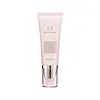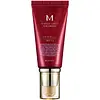What's inside
What's inside
 Key Ingredients
Key Ingredients

 Benefits
Benefits

 Concerns
Concerns

 Ingredients Side-by-side
Ingredients Side-by-side

Water
Skin ConditioningCyclopentasiloxane
EmollientCyclohexasiloxane
EmollientButylene Glycol
HumectantGlycerin
HumectantMica
Cosmetic ColorantPEG-10 Dimethicone
Skin ConditioningCI 77891
Cosmetic ColorantNiacinamide
SmoothingPentylene Glycol
Skin ConditioningDisteardimonium Hectorite
StabilisingDiamond Powder
AbrasiveMoringa Oleifera Seed Oil
EmollientRuby Powder
Skin ConditioningAmethyst Powder
AbrasivePearl Powder
Tourmaline
Chrysanthemum Morifolium Flower Extract
Skin ConditioningJasminum Officinale Extract
MaskingPlatinum Powder
AbrasiveDicaprylyl Carbonate
EmollientMagnesium Sulfate
Methyl Methacrylate Crosspolymer
Triethoxycaprylylsilane
Ethylhexylglycerin
Skin ConditioningAcrylates/Dimethicone Copolymer
Skin ConditioningAdenosine
Skin ConditioningMannan
Squalane
EmollientPolymethylsilsesquioxane
Caprylic/Capric Triglyceride
MaskingTocopherol
AntioxidantTalc
AbrasiveDisodium EDTA
Phenoxyethanol
PreservativeParfum
MaskingWater, Cyclopentasiloxane, Cyclohexasiloxane, Butylene Glycol, Glycerin, Mica, PEG-10 Dimethicone, CI 77891, Niacinamide, Pentylene Glycol, Disteardimonium Hectorite, Diamond Powder, Moringa Oleifera Seed Oil, Ruby Powder, Amethyst Powder, Pearl Powder, Tourmaline, Chrysanthemum Morifolium Flower Extract, Jasminum Officinale Extract, Platinum Powder, Dicaprylyl Carbonate, Magnesium Sulfate, Methyl Methacrylate Crosspolymer, Triethoxycaprylylsilane, Ethylhexylglycerin, Acrylates/Dimethicone Copolymer, Adenosine, Mannan, Squalane, Polymethylsilsesquioxane, Caprylic/Capric Triglyceride, Tocopherol, Talc, Disodium EDTA, Phenoxyethanol, Parfum
Water
Skin ConditioningCyclomethicone
EmollientEthylhexyl Methoxycinnamate
UV AbsorberZinc Oxide
Cosmetic ColorantPropylene Glycol
HumectantTitanium Dioxide
Cosmetic ColorantCaprylic/Capric Triglyceride
MaskingPEG-10 Dimethicone
Skin ConditioningCetyl PEG/PPG-10/1 Dimethicone
EmulsifyingArbutin
AntioxidantParaffinum Liquidum
EmollientGlycerin
HumectantCI 77492
Cosmetic ColorantPolyethylene
AbrasiveTalc
AbrasivePhenyl Trimethicone
Skin ConditioningBeeswax
Emulsion StabilisingSodium Chloride
MaskingCI 77491
Cosmetic ColorantCI 77499
Cosmetic ColorantMethylparaben
PreservativeDimethicone
EmollientPropylparaben
PreservativeRosa Canina Fruit Oil
EmollientSimmondsia Chinensis Seed Oil
EmollientSqualane
EmollientHydrolyzed Collagen
EmollientMacadamia Ternifolia Seed Oil
EmollientDisodium EDTA
Adenosine
Skin ConditioningAlgae Extract
EmollientRosmarinus Officinalis Leaf Extract
AntimicrobialChamomilla Recutita Flower Extract
MaskingSodium Hyaluronate
HumectantFagus Sylvatica Bud Extract
TonicCeramide 3
Skin ConditioningParfum
MaskingHydroxyisohexyl 3-Cyclohexene Carboxaldehyde
MaskingButylphenyl Methylpropional
PerfumingBenzyl Salicylate
PerfumingHydroxycitronellal
PerfumingAlpha-Isomethyl Ionone
PerfumingHexyl Cinnamal
PerfumingLinalool
PerfumingCitronellol
PerfumingWater, Cyclomethicone, Ethylhexyl Methoxycinnamate, Zinc Oxide, Propylene Glycol, Titanium Dioxide, Caprylic/Capric Triglyceride, PEG-10 Dimethicone, Cetyl PEG/PPG-10/1 Dimethicone, Arbutin, Paraffinum Liquidum, Glycerin, CI 77492, Polyethylene, Talc, Phenyl Trimethicone, Beeswax, Sodium Chloride, CI 77491, CI 77499, Methylparaben, Dimethicone, Propylparaben, Rosa Canina Fruit Oil, Simmondsia Chinensis Seed Oil, Squalane, Hydrolyzed Collagen, Macadamia Ternifolia Seed Oil, Disodium EDTA, Adenosine, Algae Extract, Rosmarinus Officinalis Leaf Extract, Chamomilla Recutita Flower Extract, Sodium Hyaluronate, Fagus Sylvatica Bud Extract, Ceramide 3, Parfum, Hydroxyisohexyl 3-Cyclohexene Carboxaldehyde, Butylphenyl Methylpropional, Benzyl Salicylate, Hydroxycitronellal, Alpha-Isomethyl Ionone, Hexyl Cinnamal, Linalool, Citronellol
 Reviews
Reviews

Ingredients Explained
These ingredients are found in both products.
Ingredients higher up in an ingredient list are typically present in a larger amount.
Adenosine is in every living organism. It is one of four components in nucleic acids that helps store our DNA.
Adenosine has many benefits when used. These benefits include hydrating the skin, smoothing skin, and reducing wrinkles. Once applied, adenosine increases collagen production. It also helps with improving firmness and tissue repair.
Studies have found adenosine may also help with wound healing.
In skincare products, Adenosine is usually derived from yeast.
Learn more about AdenosineThis ingredient is an emollient, solvent, and texture enhancer. It is considered a skin-softener by helping the skin prevent moisture loss.
It helps thicken a product's formula and makes it easier to spread by dissolving clumping compounds.
Caprylic Triglyceride is made by combining glycerin with coconut oil, forming a clear liquid.
While there is an assumption Caprylic Triglyceride can clog pores due to it being derived from coconut oil, there is no research supporting this.
Learn more about Caprylic/Capric TriglycerideDisodium EDTA plays a role in making products more stable by aiding other preservatives.
It is a chelating agent, meaning it neutralizes metal ions that may be found in a product.
Disodium EDTA is a salt of edetic acid and is found to be safe in cosmetic ingredients.
Learn more about Disodium EDTAGlycerin is already naturally found in your skin. It helps moisturize and protect your skin.
A study from 2016 found glycerin to be more effective as a humectant than AHAs and hyaluronic acid.
As a humectant, it helps the skin stay hydrated by pulling moisture to your skin. The low molecular weight of glycerin allows it to pull moisture into the deeper layers of your skin.
Hydrated skin improves your skin barrier; Your skin barrier helps protect against irritants and bacteria.
Glycerin has also been found to have antimicrobial and antiviral properties. Due to these properties, glycerin is often used in wound and burn treatments.
In cosmetics, glycerin is usually derived from plants such as soybean or palm. However, it can also be sourced from animals, such as tallow or animal fat.
This ingredient is organic, colorless, odorless, and non-toxic.
Glycerin is the name for this ingredient in American English. British English uses Glycerol/Glycerine.
Learn more about GlycerinParfum is a catch-all term for an ingredient or more that is used to give a scent to products.
Also called "fragrance", this ingredient can be a blend of hundreds of chemicals or plant oils. This means every product with "fragrance" or "parfum" in the ingredients list is a different mixture.
For instance, Habanolide is a proprietary trade name for a specific aroma chemical. When used as a fragrance ingredient in cosmetics, most aroma chemicals fall under the broad labeling category of “FRAGRANCE” or “PARFUM” according to EU and US regulations.
The term 'parfum' or 'fragrance' is not regulated in many countries. In many cases, it is up to the brand to define this term.
For instance, many brands choose to label themselves as "fragrance-free" because they are not using synthetic fragrances. However, their products may still contain ingredients such as essential oils that are considered a fragrance by INCI standards.
One example is Calendula flower extract. Calendula is an essential oil that still imparts a scent or 'fragrance'.
Depending on the blend, the ingredients in the mixture can cause allergies and sensitivities on the skin. Some ingredients that are known EU allergens include linalool and citronellol.
Parfum can also be used to mask or cover an unpleasant scent.
The bottom line is: not all fragrances/parfum/ingredients are created equally. If you are worried about fragrances, we recommend taking a closer look at an ingredient. And of course, we always recommend speaking with a professional.
Learn more about ParfumPeg-10 Dimethicone is silicone with conditioner and emulsifier properties. It mostly acts as an emollient in skincare and and humectant in haircare.
According to the manufacturer, acidic formulations decrease the stability of this ingredient. It works best in neutral or near neutral formulations.
Squalane is an emollient that helps the skin hold onto moisture. It's an oily liquid that occurs naturally in certain types of fish and plant oils.
Because squalane boosts hydration in the skin, it also comes with plenty of benefits: it is an antioxidant and can help fight free radicals and skin damage. Squalane is also found to have a detoxifying effect when applied.
Squalane comes from squalene, which occurs naturally within the sebum of our skin. It is one of the oils our skin produces to keep itself hydrated. Squalane is the hydrogenated version of squalene and has a longer shelf life.
Research shows that squalane is non-irritating (even at 100% concentration).
In general, it's a fantastic ingredient. It does a great job at hydrating the skin, and it's suitable for those with sensitive skin.
The source of squalane may impact malassezia / fungal acne. This is because olive oil derived squalane can contain impurities such as fatty acids and plant waxes. Sugarcane derived squalane is recommended for anyone with malassezia concerns.
Is squalane vegan?
This depends on the source. Squalane can be derived from both plants and animals. Most squalane used in skincare comes from plants.
Please note: the source of squalane is only known if disclosed by the brand. We recommend reaching out to the brand if you have any questions about their squalane.
Read more about squalene with an "e".
Is squalane an oil?
Squalane is often called an oil, but it’s technically not; it’s a hydrocarbon, meaning it’s only made of carbon and hydrogen, unlike true oils which are triglycerides made of fatty acids and glycerol.
The term “oil-free” isn’t regulated, so companies can define it however they want. Some exclude all oils, while others just avoid mineral oil or comedogenic oils.
While some people avoid oils thinking they cause breakouts, the right kind of oil (or oil-like ingredient like squalane) can actually help balance and hydrate your skin. It’s worth testing out simple oils or squalane to see what works best for your skin.
Learn more about SqualaneTalc is a clay mineral. It helps absorb moisture and improve the texture of products. Like other types of clay, Talc can have a slight exfoliating effect on skin. Talc can be added to increase the volume of products.
Some Baby powders are made by combining talc with corn starch. The word "talc" comes from Latin and originates from Arabic. Talc is a mineral commonly found throughout the world.
If you have any concerns about using talc, we recommend checking out the FDA's official page.
Learn more about TalcWater. It's the most common cosmetic ingredient of all. You'll usually see it at the top of ingredient lists, meaning that it makes up the largest part of the product.
So why is it so popular? Water most often acts as a solvent - this means that it helps dissolve other ingredients into the formulation.
You'll also recognize water as that liquid we all need to stay alive. If you see this, drink a glass of water. Stay hydrated!
Learn more about Water